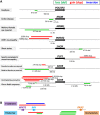Non-coding genetic variants in human disease
- PMID: 26152199
- PMCID: PMC4572001
- DOI: 10.1093/hmg/ddv259
Non-coding genetic variants in human disease
Abstract
Genetic variants, including single-nucleotide variants (SNVs) and copy number variants (CNVs), in the non-coding regions of the human genome can play an important role in human traits and complex diseases. Most of the genome-wide association study (GWAS) signals map to non-coding regions and potentially point to non-coding variants, whereas their functional interpretation is challenging. In this review, we discuss the human non-coding variants and their contributions to human diseases in the following four parts. (i) Functional annotations of non-coding SNPs mapped by GWAS: we discuss recent progress revealing some of the molecular mechanisms for GWAS signals affecting gene function. (ii) Technical progress in interpretation of non-coding variants: we briefly describe some of the technologies for functional annotations of non-coding variants, including the methods for genome-wide mapping of chromatin interaction, computational tools for functional predictions and the new genome editing technologies useful for dissecting potential functional consequences of non-coding variants. (iii) Non-coding CNVs in human diseases: we review our emerging understanding the role of non-coding CNVs in human disease. (iv) Compound inheritance of large genomic deletions and non-coding variants: compound inheritance at a locus consisting of coding variants plus non-coding ones is described.
© The Author 2015. Published by Oxford University Press. All rights reserved. For Permissions, please email: journals.permissions@oup.com.
Figures

References
Publication types
MeSH terms
Grants and funding
LinkOut - more resources
Full Text Sources
Other Literature Sources

